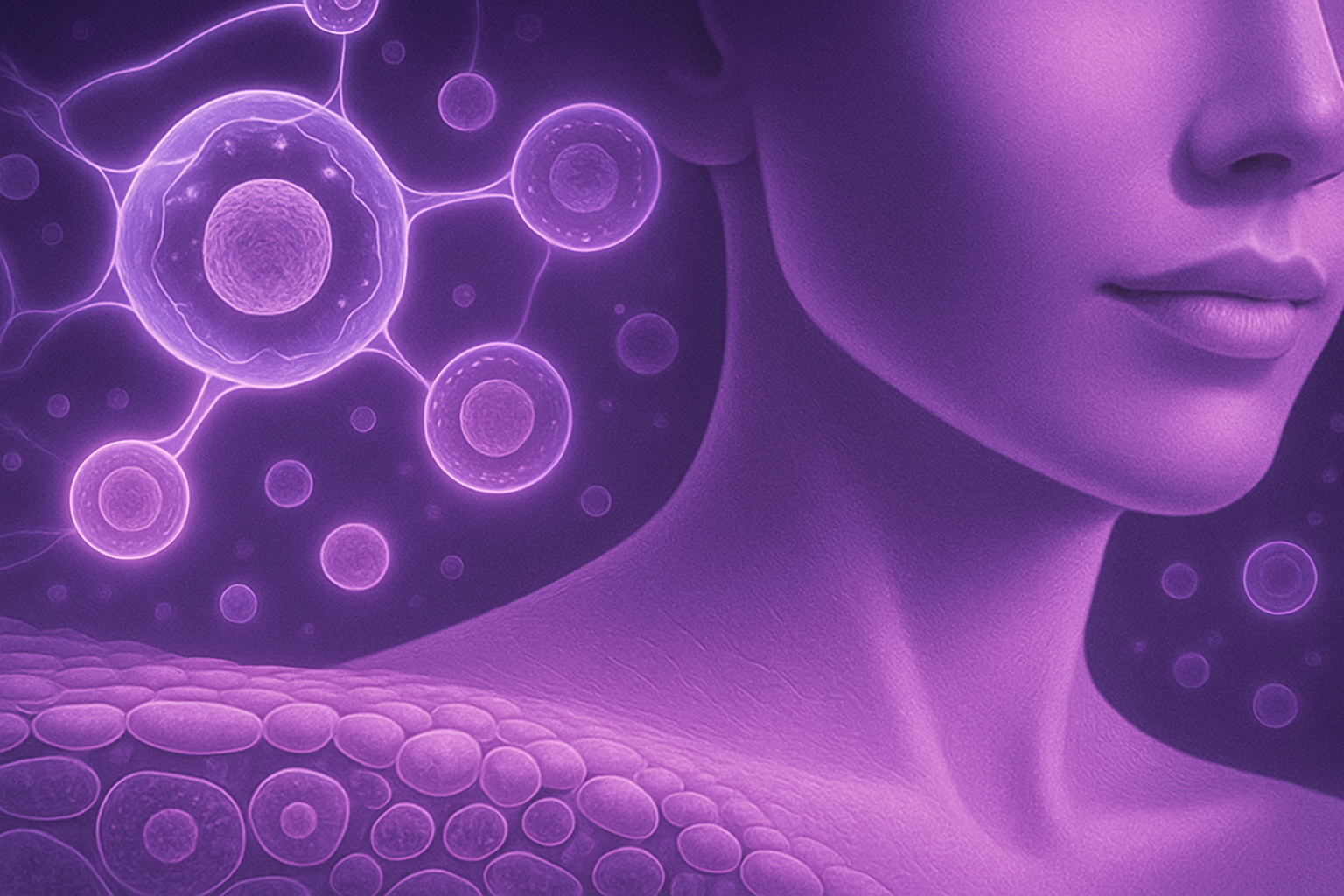
Jodi Brichan
The Future of Youthful Skin: Why Cellular Longevity Matters More Than Cellular Health
June 6, 2025
When you think of skin aging, what comes to mind? Wrinkles, sagging, maybe a few dark spots. But proper aging runs much deeper than what meets the eye. Like your muscles, your skin loses its functional capacity over time— the ability to regenerate, repair, and defend itself. This blog explores the science of functional skin aging, why it matters, and how understanding it changes how we approach skin longevity.
What Is Functional Aging?
Functional aging refers to the gradual decline in how well our cells and organs perform their core biological duties. Unlike surface-level symptoms, functional decline happens at the cellular level. This means slower cell turnover, weaker defenses, and reduced production of structural proteins like collagen and elastin for your skin. The result? A complexion that becomes thinner, more sensitive, and less resilient with time.
Your Skin Isn’t So Different from Your Muscles
We don’t often think of muscles and skin as similar, but they age similarly. As we age, our muscles lose not just strength but also efficiency. This is the essence of functional muscle aging. It’s not just about being weaker; it’s about losing the energy, balance, and resilience to perform everyday tasks.
The skin works similarly. It protects us from UV damage, pathogens, and pollution. But as functional skin aging sets in, it becomes slower to heal, easier to inflame, and less effective at defending itself. Just as weak muscles lead to falls and frailty, aged skin becomes more vulnerable to chronic conditions, irritation, and even disease.
The Cellular Drivers Behind Skin Aging
Under the surface, several processes drive skin aging:
- Senescence: Damaged skin cells stop dividing but don't die. [1] Instead, they linger and secrete inflammatory compounds in the SASP (senescence-associated secretory phenotype), accelerating tissue breakdown. [1]
- Inflammaging: As more senescent cells accumulate, they trigger chronic, low-grade inflammation that weakens the skin barrier and leads to redness, sensitivity, and a breakdown in repair processes. [2]
- Oxidative Stress: Daily exposure to UV rays and pollution creates reactive oxygen species (ROS) that damage DNA and cellular membranes. [3]
Decline in Collagen and Elastin: As we age, fibroblasts become sluggish, leading to a reduction in the proteins responsible for skin firmness and elasticity.
- Delayed Healing: Aging skin responds more slowly to cuts, irritation, or environmental stress, losing its capacity to bounce back quickly.
Longevity Isn’t Just Living Longer—It’s Functioning Better
Supporting skin health span means keeping your skin cells healthy and efficient for as long as possible. This is the foundation of cellular longevity. When skin cells retain their functional abilities—like detoxifying, regenerating, and producing structural proteins—your skin ages more slowly and maintains its youthful capacity.
To promote long-term skin health, we need to support key longevity pathways:
- mTOR inhibition (especially TORC1 targeting): Slows down aging by reducing cellular overactivation. [4]
- Autophagy: The process by which cells clean up damaged components. [5]
- Master regulators of aging like SIRT1, AMPK, and NRF2: These proteins help maintain cellular balance and prevent cellular dysregulation. [6] [7] [8]
Why Functional Skin Aging Matters More Than Ever
Most skincare focuses on symptoms. But treating aging at the root cause means focusing on cellular reprogramming, reducing senescence, and preserving the skin's biological age. [1] It’s not just about smoother skin—it’s about skin that continues to protect, repair, and regenerate itself.
Because youthfulness isn’t just about glow—it’s about strength, resilience, and vitality. When your skin functions like it did in your twenties, you don’t just look younger. You live younger.
Key Takeaway: Treat Skin Aging Like a Longevity Problem
The science is precise: your skin ages like your muscles from the inside out. If you want real results, go beyond the mirror. Target the root biology, support your skin longevity, and invest in pro-longevity skincare that works with your body, not just on top of it.
Keywords Integrated: functional aging, functional skin aging, functional muscle aging, hallmarks of aging, root causes, cellular dysregulation, functional decline, health and longevity, functional capacity, inflammaging, resilience, repair, protection, youthfulness, strength, confidence, energy, freedom, vitality, quality of life, senescence, senolytics, xenomorphic, cellular longevity, skin healthspan, longevity pathways, mTOR inhibition, autophagy, cellular balance, cellular reprogramming, skin biological age, pro-longevity skincare, master regulators of aging
References
1. Campisi, Judith. “Aging, Cellular Senescence, and Cancer.” Annual Review of Physiology, vol. 75, 2013, pp. 685–705.
2. Franceschi, Claudio, and Judith Campisi. “Chronic Inflammation (Inflammaging) and Its Potential Contribution to Age-Associated Diseases.” The Journal of Clinical Investigation, vol. 123, no. 3, 2014, pp. 973–979.
3. Liguori, Ilaria, et al. “Oxidative Stress, Aging, and Diseases.” Oxidative Medicine and Cellular Longevity, vol. 2018, Article ID 7915180.
4. Johnson, Simon C., et al. “TOR Signaling: The Aging Pathway.” Nature, vol. 493, 2013, pp. 338–345.
5. Levine, Beth, and Guido Kroemer. “Autophagy in the Pathogenesis of Disease.” Cell, vol. 132, no. 1, 2008, pp. 27–42.
6. Guarente, Leonard. “Sirtuins in Aging and Disease.” Genes & Development, vol. 21, no. 13, 2007, pp. 1645–1658.
7. Hardie, D. Grahame, et al. “AMP-Activated Protein Kinase: An Energy Sensor That Regulates All Aspects of Cell Function.” Nature Reviews Molecular Cell Biology, vol. 13, 2012, pp. 251–262.
8. Ma, Qiang. “Role of Nrf2 in Oxidative Stress and Toxicity.” Toxicology and Applied Pharmacology, vol. 238, no. 3, 2013, pp. 305–314.